 November 2024
Nature's Secret Gardens: Moss and Lichen 🌿🏵️
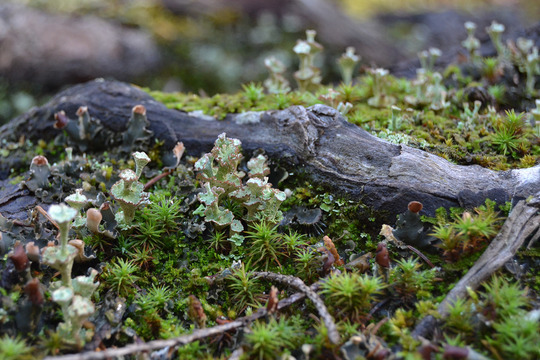 📷: Carolyn Rock, Gooseberry Falls State Park
As November settles in and the trees shed their last leaves, a hidden world emerges in our state parks—nature’s secret gardens of moss and lichen. These resilient organisms, often overlooked during the bustling summer months, now take center stage on bare rocks, tree trunks, and forest floors.
Mosses and lichens are nature’s quiet healers. They play a vital role in the ecosystem, supporting moisture retention, nurturing soil health, and providing shelter for tiny creatures. Their understated beauty and persistence remind us of the power in life’s quieter moments. Observing them can be a deeply mindful activity, a chance to reflect on the small, often unnoticed aspects of our surroundings that make a big impact—much like these tiny plants themselves.
This month, we encourage you to explore the quiet beauty of moss and lichen on your next visit to a state park. Take a moment to pause, look closely, and let nature’s secret gardens inspire a season of reflection and appreciation for life’s simpler gifts.

The Forest's Carpet: Moss
Mosses—and their relatives, collectively known as bryophytes—are some of the oldest plants on Earth, and though they lack roots, flowers, and even a vascular system, they play an essential role in the ecosystem. These resilient plants absorb water directly through their leaves, which allows them to thrive in environments that range from dense forests to exposed rocks.
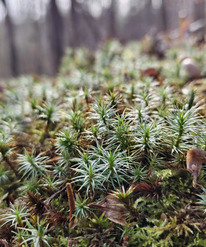
Mosses are a sanctuary for small creatures, providing shelter and sustenance for tiny insects, spiders, and even frogs. By taking a closer look, you might catch a glimpse of the intricate world that exists within this green carpet. Each clump of moss is like a miniature forest, with layers of texture and shades of green that invite you to slow down and truly observe.
Beyond their beauty, mosses play a vital role in the environment. They act as natural sponges, retaining moisture that helps prevent soil erosion, especially in sensitive ecosystems. This water-holding capacity is invaluable in times of drought, and it helps to moderate forest humidity, supporting other plants and wildlife. Additionally, they can serve as pioneers in disturbed areas, helping to regenerate soil by breaking down minerals over time.
Identifying mosses can be a fun and mindful activity, though it requires a close look. Each of Minnesota’s 500+ species of moss has its own distinct traits, and a magnifying glass can reveal their tiny leaf structures and textures. For those looking to delve deeper, the DNR offers free field guides to help you identify Minnesota’s bryophytes, opening a window to this fascinating world.
|
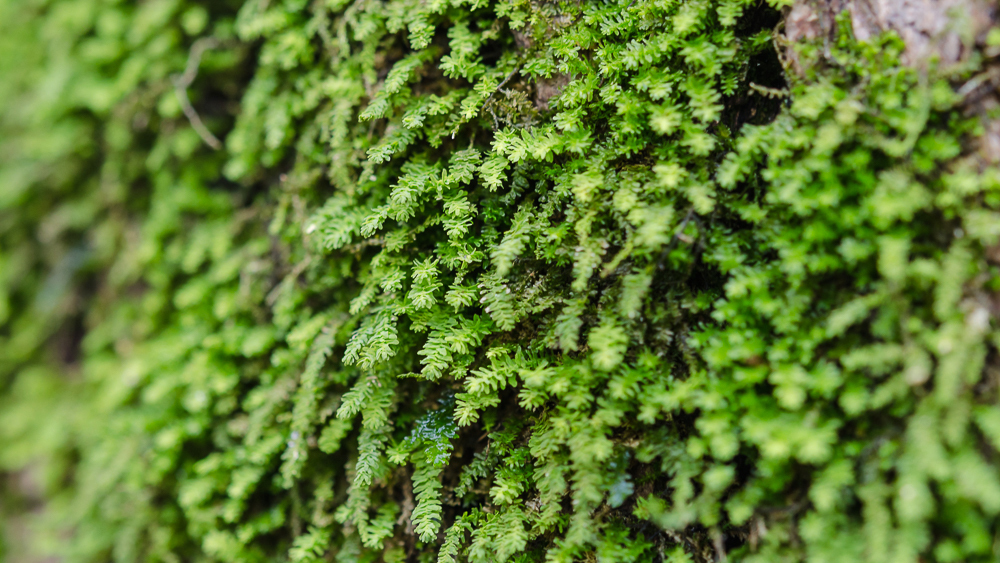 📷: Sara Simma, Wild River State Park
🌿 Wild River State Park
Tucked along the trails and blanketing the forest floor, moss thrives in Wild River State Park's lush, shaded areas. The park’s damp conditions make it an ideal habitat for numerous moss species. The soft, growths of green create a vibrantly contrasting landscape in the otherwise rusty orange and brown of late fall.
Mark your calendars! 📅
Join the naturalist at Wild River State Park for a 'Mysterious Moss Walk' on November 29—which also happens to be Free Park Day! Meet at the park's visitor center at 2 p.m. for a journey into the world of moss. The event is great for kids and adults—plus, there will be investigation tools for hands-on activities. The walk is on a relatively flat trail (paved, then mowed grass) and will cover about 1/2 mile. Dress for the weather, we'll see you there!
🌿 Nerstrand Big Woods State Park
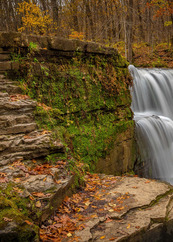
For those interested in viewing moss species, Nerstrand Big Woods State Park is a treasure trove. The damp environment allows for a variety of moss types, from low-growing sheets to delicate, feathery structures. Step into the forest of Nerstrand Big Woods State Park and you’ll find yourself surrounded by a lush tapestry of plant life, including mosses. Look for them growing on the trunks of trees as well as on the limestone outcrops of Hidden Falls. This quiet, unassuming plant thrives in the park’s shaded, moist woodlands, adding to the serenity of the towering maples, basswoods, oaks and elms.
|
🌿 Lake Bemidji State Park
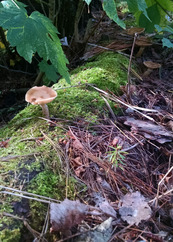
For visitors walking through Lake Bemidji State Park’s wetlands, moss may seem like just a soft, green backdrop. However, these delicate plants are foundational to the health and stability of wetland ecosystems. Moss absorb water directly through their leaves, making them well-suited to the wet and humid conditions found in areas like the Bog Walk Trail and boardwalk at Lake Bemidji State Park. This ability allows mosses to grow in mats and cushions, creating soft, spongy layers that retain moisture and provide habitat for various microorganisms, insects, and other tiny creatures.
|
🌿 Mini But Mighty: Water Bears
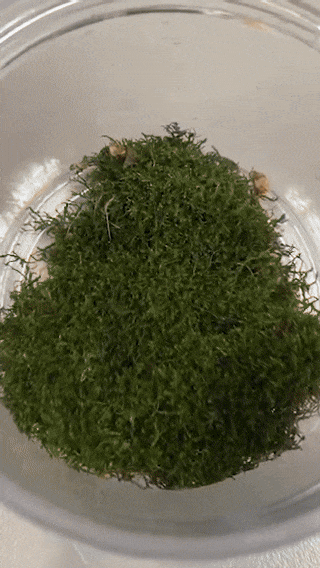
What is older than dinosaurs, has eight legs, lives in Minnesota moss, and has been to outer space?
Water bears! Tardigrades, first described in 1773 as 'little water bear' (due to their chunky bodies, short legs, and claws) have been on Earth about 600 million years—preceding the dinosaurs by about 400 million years. If you haven't guessed, water bears are one tough critter! They can go 30 years without food or water.
The image to the right was taken by our naturalist at Tettegouche State Park, Kurt Mead. "I have always been curious about water bears. Everyone says that they are all over the place, but who has actually gone out to find them?"
A little experiment was all it took—"I collected about a square inch of moss from on top of a rock, wetted it down, and by the next day, there were multiple water bears visible through my dissecting scope."
As for the water bears' journey to outer space—In 2019, thousands of tardigrades were carried on the spacecraft Beresheet. Unfortunately, the unmanned spacecraft crash landed on the moon. Later experiments showed the water bears likely turned to mush on impact. Bummer!
|
Lichen What You See
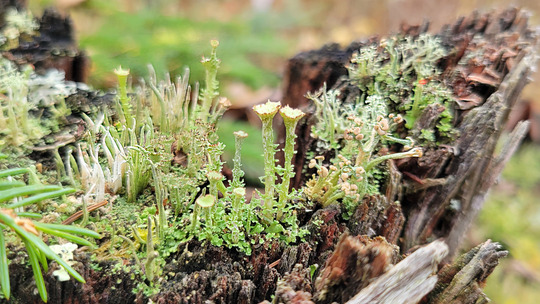 📷: Christine Winans, La Salle Lake State Recreation Area
Lichens are fascinating organisms that are neither plant nor animal. They’re a unique combination of fungi and either algae or cyanobacteria, living together in a symbiotic relationship where each supports the other’s survival. The fungus provides structure and absorbs water and minerals, while the algae or cyanobacteria use sunlight to produce energy through photosynthesis, creating food that both organisms can share. This partnership allows lichens to survive in some of the harshest environments on Earth, from scorching deserts to the icy reaches of the South Pole.
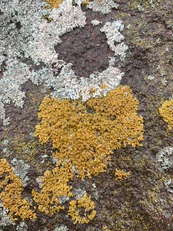
In Minnesota, there are upwards of 750 lichen species, many of which are the first life forms to colonize bare rock after glaciers retreat or natural events like fires clear the land. Using root-like threads and mild acids, lichens slowly break down rock, beginning the process of soil formation. This ability to 'pioneer' new ground is crucial for creating habitats that can eventually support larger plants and entire ecosystems.
Beyond their beauty, lichens are vital to Minnesota’s ecosystems. They serve as food for animals such as squirrels, deer, and spruce grouse. In winter, when food is scarce, lichens provide a rich source of carbohydrates for wildlife. Birds like the ruby-throated hummingbird, boreal chickadee, and white-winged crossbill use lichens to pad their nests. The northern parula warbler even builds its nest directly in old man’s beard, a type of lichen that hangs like wispy threads from trees in Minnesota’s forests.
Lichens are also natural air quality indicators. They absorb pollutants like sulfur dioxide, a byproduct of burning fossil fuels. When pollution levels are high, lichens struggle to survive, making their presence a symbol of the clean, fresh air found in Minnesota’s state parks. Next time you visit, take a closer look at these quiet but powerful guardians of the wilderness.
|
🏵️ Interstate State Park
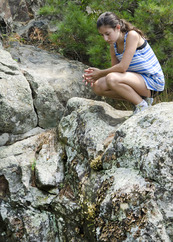
Interstate State Park is famous for its unique geology, with deep potholes carved by glacial rivers and striking rock formations along the St. Croix River. But look closely, and you’ll find tiny worlds thriving on the surfaces of these ancient stones: lichens.
At Interstate State Park, lichen come in a variety of shapes and colors, from silvery greens and grays to earthy browns and vibrant oranges. These hardy organisms cling to rocky outcrops, surviving in harsh conditions where other plants can’t. Lichens don’t need soil; they draw nutrients from the air, sunlight, and rain, allowing them to thrive directly on stone surfaces. Over time, they even contribute to breaking down rock into soil, playing a subtle but essential role in shaping the landscape.
Walk along the trails in the glacial potholes area and you’ll see lichens scattered across rocks like natural artwork. Next time you visit Interstate, pause to appreciate these tiny, resilient workers. They are a reminder of the power of small things, quietly contributing to Minnesota’s natural beauty and history.
|
🏵️ Gooseberry Falls State Park
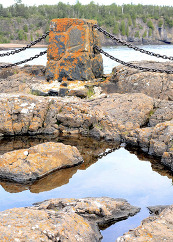
Besides the falls themselves, Gooseberry Falls State Park can often be remembered for its striking orange lichen, a vivid pop of color against the rugged rocks along the North Shore. Species like the Elegant Sunburst Lichen (Rusavskia elegans) decorate the rocky cliffs with orange along the North Shore.
A variety of colorful lichen, with their hues ranging from vibrant orange and green to grey, add a unique contrast to the park’s rugged landscape and capture the eye of every passerby.
More than just a pretty color, these lichens are resilient workers in the ecosystem, thriving in the cool, moist environment. They play an essential role by slowly breaking down rocks into soil over time, creating the foundation for other plant life to grow. The lichens also provide valuable resources for local wildlife. Squirrels and other small animals nibble on them for energy, while birds like warblers and chickadees weave pieces into their nests. Gooseberry Falls State Park is the perfect place to slow down, take a closer look, and appreciate these vibrant, hardworking organisms.
|

 Artists-in-Residence Announced!
We're thrilled to announce the artists selected to work with Minnesota state parks through the . The inaugural cohort of artists will explore themes of community and belonging by researching and engaging with the state parks, with the goal of using their artwork to enhance a sense of welcoming and belonging to all park visitors.
Congratulations to the four artists working with Minnesota state parks:
 🎨 Nicole Rojas-Oltmanns, Lake Bemidji State Park (left)
🎨 Monica Rojas, Lake Bemidji State Park (left center)
🎨 Sam Zimmerman, Tettegouche State Park (right center)
🎨 JG Everest, Wild River State Park (right)
Learn more about the program and additional artist placements at Minnesota regional parks on the Forecast Public Art website.
Painting State Parks with Beth Anne Dugan
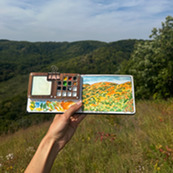
Speaking of art, we're excited to share the artistic stylings of Beth Anne Dugan. Beth is a multi-disciplinary, multi-media visual artist based in the Twin Cities. On top of creating beautiful paintings, drawings, and designs featuring nature, Beth also creates her artwork outside too! Beth explains, "Perhaps it is the feeling of isolation when creating alone in nature that means the most to me. The feeling that nothing is watching me is tempered by the feeling that really maybe everything is. Creating outside provides a safe place for mistakes and an energetic atmosphere for discovery." Learn more about Beth's process below and watch her visit to Great River Bluffs State Park.
|
 Mark Your Calendars for Nov. 29 

This Black Friday, choose the beauty of nature over the bustle of the mall!
On Friday, November 29, we're celebrating a different kind of deal - Free Park Day in Minnesota's state parks. Visitors will enjoy free entrance to all Minnesota state parks and recreation areas—no vehicle permit needed. Opt outside with us and enjoy the crisp autumn air, stillness of our forests, wonders of our trails, and maybe even some snow?
Step away from the shopping frenzy and into the tranquility of nature. Bring your friends and family, pack a picnic, and make memories that will last a lifetime. Mark your calendars for November 29—we'll see you soon!
Father Hennepin State Park Reopens
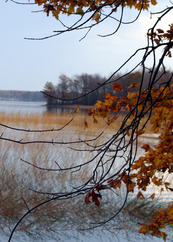
The gates at Father Hennepin State Park are open! After a two-month closure, the park is ready to welcome visitors just in time for the end of fall.
In early September, Father Hennepin State Park closed to upgrade its aging wastewater system, which had long surpassed its useful life. With more visitors bringing larger RVs and camping rigs, the new system will better accommodate the park's growing popularity and ensure it remains equipped to meet future demand.
|
|
